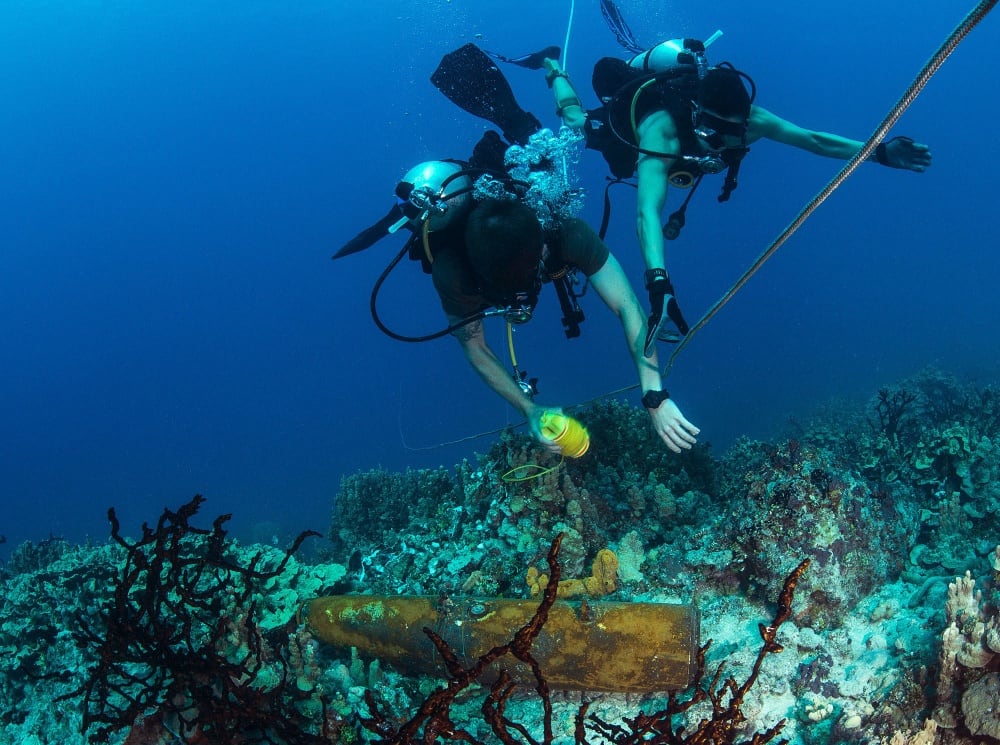For much of the past few decades, an outsider’s image of an explosive ordnance disposal sailor would likely evoke a brave soul conducting the dangerous but vital task of disabling an improvised explosive device, be it a crude fertilizer jug array in Afghanistan or something more complex on a road in Iraq.
But within the ranks, the 1,800-strong community has always been sea-based, and every EOD tech is also a certified diver tasked with clearing the way forward, no matter the domain.
Now, as the rest of the military continues to pivot toward preparing for a conventional war as part of the so-called “great power competition,” the EOD force has released a new strategic vision for the coming decade, and how it will contribute to that fight.
With the huge demand across the military for their kind of expertise in recent decades, the Navy’s EOD sailors were called upon to serve the vital role of clearing roads in Iraq and Afghanistan from IED threats, Capt. Richard Hayes, the commodore for Explosive Ordnance Disposal Group 2, told reporters Thursday.
RELATED

“Now that we have less capacity dedicated to those land missions, we are spending a bit more time in the maritime domain,” Hayes said. “The water is our primary domain.”
At the same time, the mission of clearing the way for other parts of the joint force in Iraq and Afghanistan is informing the EOD community as it again refocuses on the water, and the undersea domain in particular, Capt. Oscar Rojas, the commodore of EOD Group 1, added.
“We make sure there is not a single waterway that we are not able to gain access to,” Rojas said.
While new efforts laid out in the strategic plan touch on everything from advancing the community’s cyber capabilities to fast-tracking the acquisition and development of new systems and a bevy of goals aimed at looking after the physical, social and mental well-being of EOD sailors, the pivot largely focuses on the “Expeditionary Mine Countermeasures” program, where EOD sailors deploy Mark 18 underwater drones from ships in order to clear areas of water.
The EOD force has had unmanned undersea vehicles, or UUVs, dating back to 2001, but the use of such vehicles really took off with the establishment of the ExMCM effort in 2012.
“I think it’s pretty safe to say that no one is operating UUVs to the volume we are,” Hayes said. “I’m talking globally … we have elements of our commands putting UUVs in the water every day.”
That program is also a big driver behind the EOD force’s aim to expand its ranks and bring in new ratings not traditionally associated with the community.

To help beef up those ranks, the Navy announced earlier this month new rating conversion opportunities for sailors ranked E-1 to E-5 who are interested in joining the Navy’s diver and EOD programs.
The new strategic plan also acknowledges that, like the rest of the U.S. military, the EOD is entering an age of rapidly evolving technology and unknowns.
“We can expect to encounter weapons that are more difficult to detect and locate, more dangerous to render safe and recover, more complicated to exploit, and for which we have no EOD technical manuals,” the plan states. “Meeting the challenge of networked munitions, interconnected sensors, and programmable electronics that can be controlled from anywhere in the world via the internet will require new EOD skills, equipment and procedures.”
Geoff is the managing editor of Military Times, but he still loves writing stories. He covered Iraq and Afghanistan extensively and was a reporter at the Chicago Tribune. He welcomes any and all kinds of tips at geoffz@militarytimes.com.





